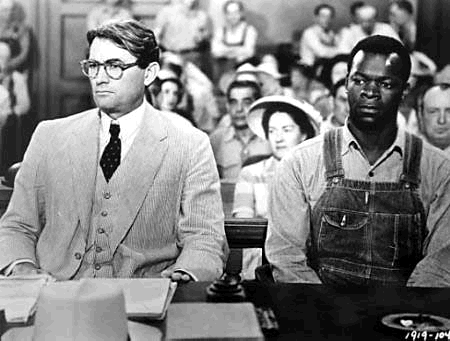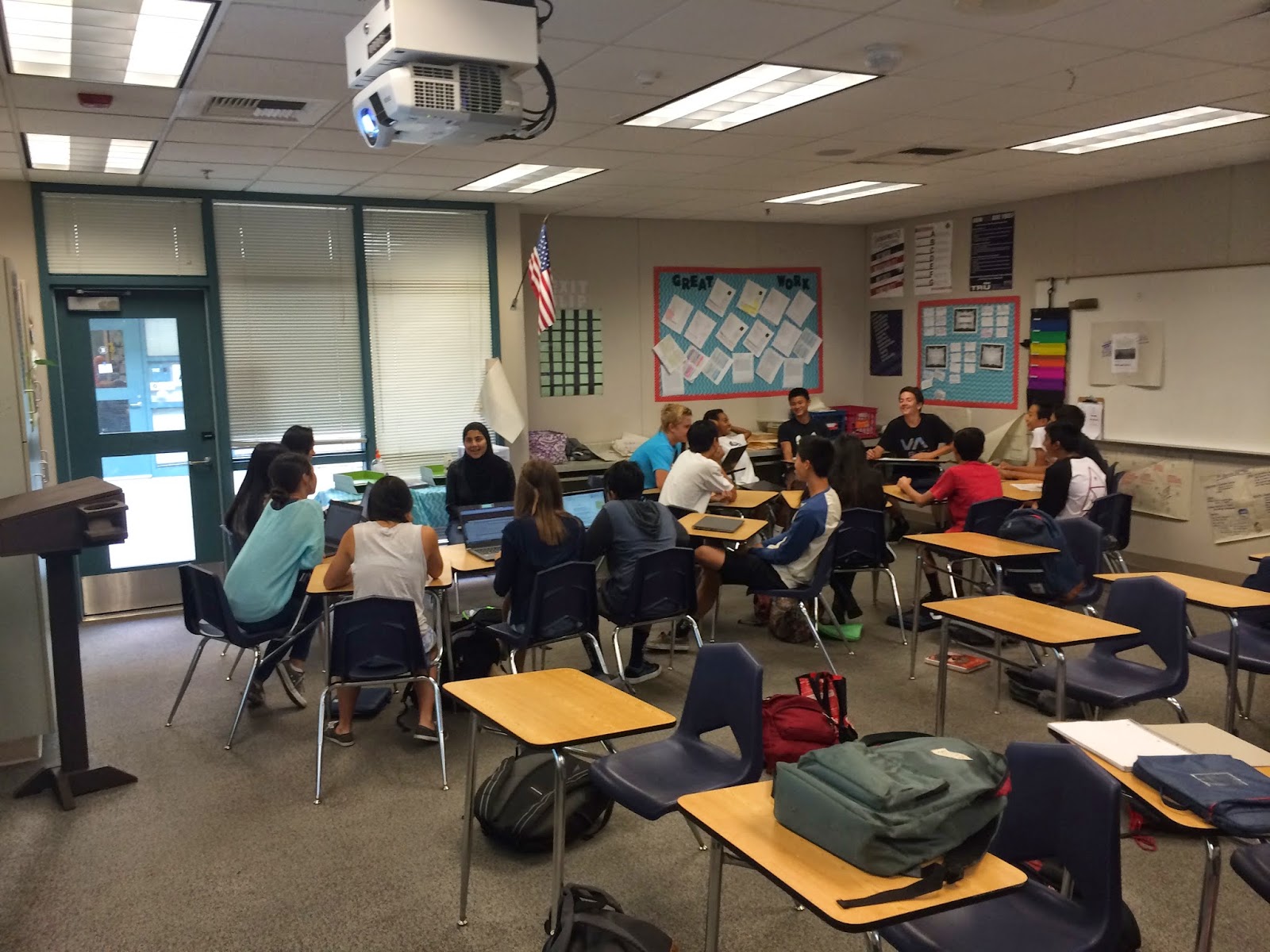Dawn Lam is an English Teacher at Beckman High School and one of my amazing fellows this school year. After attending #EdCampUCLACenterX a few weeks ago, she came back with the idea of doing an EdCamp-Style discussion called an EdCafe. I can't take any credit for her planning or implementation because she just took the idea and ran with it (which I LOVE!) - thankfully, I was able to sit in and be a part of one of her class periods during the EdCafe to see the awesomeness that unfolded. I asked her to write a guest blog post here at Flipping with Kirch to share how she came about the idea of an EdCafe, describe her process, and reflect on the implementation and impact on student learning. You can follow Dawn on Twitter @MrsLamBHS
~~~
Thank you, Crystal for allowing me to be a guest blogger! Working with Crystal has been such an awesome learning experience and I feel so fortunate to have her as a coach/mentor.
 |
| http://upload.wikimedia.org/wikipedia/commons /c/ce/Atticus_and_Tom_Robinson_in_court.gif |
I came across the Edcafe model after attending an Edcamp earlier in the month. I tweeted about my experience and a response mentioned that I should check out the student version, Edcafes at http://whatisanedcafe.wordpress.com/. As soon as I read through Katrina’s site, I knew I wanted to try out this discussion model in my English classroom.
Essentially in an Edcafe, 4 students act as facilitators and lead a discussion centered on a topic of their choosing in each corner of the classroom. The rest of the class gets to decide which of the 4 discussions they’d like to attend based on in their interest in the topic. After the allotted time (I allowed 7 minutes for the discussion), 4 new facilitators lead discussions in the classroom corners. Therefore, a participant has the choice to attend 2 different discussions during the Edcafe. It’s a great way to offer students choice during class discussions.
 |
| http://upload.wikimedia.org/wikipedia/ commons/3/34/Dust-storm-Texas-1935.png |
My students were examining the DBQ: What Caused the Dust Bowl? to provide some historical background to the novel, To Kill a Mockingbird, and as a way to help provide them skills necessary for future AP History courses. The students were examining historical documents in groups and beginning to hypothesize the causes in preparation for an essay. To be honest, I just added the Edcafe to the lesson plans immediately, without too much planning and luckily, I was very happy with the results.
I created Google sheets for each period and handpicked my facilitators (4 per session: 2 sessions). I posted the sheets on my Haiku page and asked the facilitators to fill out the sheet with their chosen topics by the evening before the Edcafe.
Here are the questions they came up with:



Two days before the Edcafe, I showed each class the Edcamp video and posted it to my Haiku site. I orally explained my own experience as a participant at an Edcamp and ran through the main parts: facilitator introductions, discussions, and takeaways. Ideally, I would have shown them the Edcafe video, but I did not come across this until the day of our Edcafes.
Here are the questions they came up with:



Two days before the Edcafe, I showed each class the Edcamp video and posted it to my Haiku site. I orally explained my own experience as a participant at an Edcamp and ran through the main parts: facilitator introductions, discussions, and takeaways. Ideally, I would have shown them the Edcafe video, but I did not come across this until the day of our Edcafes.
The day of Edcafes, I began with a brief overview via Google slides.
Each facilitator stood up and presented their topics and classroom locations, while I had the Google sheet projected on the screen. Students had 1 minute to get to their corners and discussions began. During the first session, I noticed some facilitators had notes, research and/or questions prepared. Others informally held a discussion, posing questions to keep the discourse continuing. I put 7 minutes on the timer and as an observer, circulated the room, taking notes of what was being said and who was speaking in each corner. Once the timer went off, I again allowed 1 minute for transition to session 2.
Each facilitator stood up and presented their topics and classroom locations, while I had the Google sheet projected on the screen. Students had 1 minute to get to their corners and discussions began. During the first session, I noticed some facilitators had notes, research and/or questions prepared. Others informally held a discussion, posing questions to keep the discourse continuing. I put 7 minutes on the timer and as an observer, circulated the room, taking notes of what was being said and who was speaking in each corner. Once the timer went off, I again allowed 1 minute for transition to session 2.
After session 2, students went back to whole class seating and had 2 minutes to write a takeaway on a post-it for my exit board. One by one, each facilitator stood up and shared a takeaway from the Edcafe discussion he/she hosted.
 |
| The "Exit Board". Each student has a number and posts their sticky note on their number. |
So...what did I learn?
First of all, the Edcafe allows for student choice, which immediately makes the discussions more engaging.
Secondly, the session topics need to be posted and made available as soon as possible, so students have an opportunity to think about which discussion they’d like to attend. After researching Edcafes in more detail after our first try, I noticed I need to encourage facilitators to prepare a catchy name for their session and present a more engaging introduction to help them “sell” their session to the class.
Finally, depending on the dynamics of the class, it would be super helpful to provide facilitators a sheet to complete in order to prepare for their discussions. I came across this one and plan to adapt it to fit my students’ needs. Check out Ms. Fillingham’s site for more help!
First of all, the Edcafe allows for student choice, which immediately makes the discussions more engaging.
Secondly, the session topics need to be posted and made available as soon as possible, so students have an opportunity to think about which discussion they’d like to attend. After researching Edcafes in more detail after our first try, I noticed I need to encourage facilitators to prepare a catchy name for their session and present a more engaging introduction to help them “sell” their session to the class.
Finally, depending on the dynamics of the class, it would be super helpful to provide facilitators a sheet to complete in order to prepare for their discussions. I came across this one and plan to adapt it to fit my students’ needs. Check out Ms. Fillingham’s site for more help!
Here are some results:
After 2 Edcafes, I created a survey via Google forms to get my students’ feedback. My goal was to find out what students thought about the model, measure whether I was meeting my class objectives, and also learn from students the best way to adapt the Edcafes to meet their needs.
Thanks Dawn for sharing your EdCafe experience. Don't forget to follow Dawn @MrsLamBHS and let us know how your EdCafe experience goes!
Happy Thanksgiving Everyone!












No comments:
Post a Comment